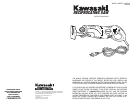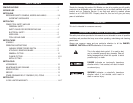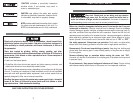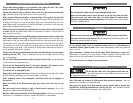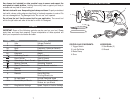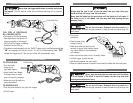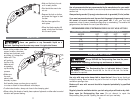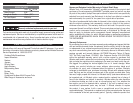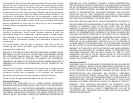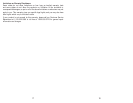
SAFETY RULES FOR RECIPROCATING SAW
Always wear safety goggles or eye protection when using this tool. Use a dust
mask or respirator for applications which generate dust.
Secure the material being worked on. Never hold it in your hand or across your
legs. Unstable support can cause loss of control and injury.
When using the Reciprocating Saw, always maintain a firm grip on the tool with
both hands. Never put your hands or feet in the cutting area. Do not grasp the tool
or place your hands too close to the blade. Keep your hands well away from the
blade. Never reach underneath the tool while the blade is in motion. Do not use your
legs or feet to stabilize the work piece.
Position yourself to avoid being caught between the tool or side handle and walls
or posts. Should the blade become bound or jammed in the work, it could result in
loss of control and injury.
Always hold the tool by its insulated gripping surfaces when cutting in areas that
may contain hidden live wiring. If the blade makes contact with a live wire, the
metal parts of this tool may conduct enough electricity to seriously shock the user.
Contact with a “live” wire will make exposed metal parts of the tool “live” and shock
the operator. Do not cut or break into existing walls or other blind areas where
electrical wiring may exist. If this situation is unavoidable, disconnect all fuses or
circuit breakers feeding this worksite.
Check to see that keys and adjusting wrenches are removed from the saw before
switching the tool “ON”. Keys or wrenches can fly away at high velocity striking
you or a bystander.
Do not run the Reciprocating Saw while carrying it at your side. A moving blade
could cause serious personal injury.
Do not use the Reciprocating Saw if it has been damaged, left outdoors in the
rain, snow, wet or damp environments, or immersed in liquid.
Do not use dull or damaged blades.
Keep cutting tools sharp and clean. Properly maintained cutting tools with sharp
cutting edges are less likely to bind and are easier to control.
When restarting a saw in the workpiece, check that teeth are not engaged in
the material.
Keep the handle of the Reciprocating Saw dry, clean, and free from oil and
grease.
Be extra careful when cutting in high or hard-to-reach locations. Be on the
lookout for hidden wires and falling debris.
Maintain labels and nameplates on the Reciprocating Saw. These carry important
information. If unreadable or missing, contact Alltrade for a replacement.
5
ELECTRICAL SAFETY
Do not abuse the power cord or use a damaged power cord.
Never use the power cord to carry the tools or pull the plug from an outlet.
Keep the power cord away from heat, oil, sharp edges or moving parts.
Replace damaged power cords immediately. Damaged power cords increase
the risk of electric shock.
WORK AREA
Make sure that the work area is appropriate and safe to prevent accidents.
Keep your work area clean and well lit. Cluttered work benches and dark work
areas may cause accidents or injury.
Do not operate power tools in explosive areas, such as in the presence of
flammable liquids, gases or dust. Power tools create sparks which may ignite the
dust or fumes.
Keep bystanders, children and visitors away while operating a power tool.
Distractions can cause you to lose control. Protect others in the work area from
debris such as chips and sparks. Provide barriers or shields as needed.
Do not use this tool in a damp or wet environment.
TOOL USE AND CARE
Do not use the power tool if the power switch does not
turn it “ON” or “OFF”. Any tool that cannot be controlled with the power switch
is dangerous and must be replaced.
Store idle tools out of reach of children and other untrained persons. Tools are
dangerous in the hands of untrained users.
Disconnect the power cord plug from the power source before making any
adjustments, changing accessories or storing the tool. Such preventive safety
measures reduce the risk of starting the tool accidentally.
6



